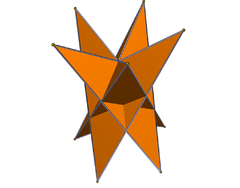Pentagrammic bipyramid
In geometry, the pentagrammic bipyramid (or dipyramid) is first of the infinite set of face-transitive star bipyramids containing star polygon arrangement of edges. It has 10 intersecting isosceles triangle faces. It is topologically identical to the pentagonal bipyramid.
| Pentagrammic bipyramid | |
|---|---|
 | |
| Type | Star bipyramid |
| Faces | 10 triangles |
| Edges | 15 |
| Vertices | 7 |
| Schläfli symbol | {} + {5/2} |
| Coxeter diagram | |
| Symmetry group | D5h, [5,2], (*225), order 20 |
| Rotation group | D5, [5,2]+, (225), order 10 |
| Dual polyhedron | pentagrammic prism |
| Face configuration | V4.4.5 |
| Properties | face-transitive, (deltahedron) |
.stl.png)
3D model of a dual uniform pentagrammic bipyramid
.stl.png)
3D model of a pentagrammic bipyramid with regular faces
Each star bipyramid is the dual of a star polygon based uniform prism.
Related polyhedra
There are two pentagrammic trapezohedra (or deltohedra), being dual to the pentagrammic antiprism and pentagrammic crossed antiprism respectively, each having intersecting kite-shaped faces (convex or concave), and a total of 12 vertices:
| {5⁄2} trapezohedron | {5⁄3} trapezohedron |
|---|---|
 |
 |
References
External links
This article is issued from Wikipedia. The text is licensed under Creative Commons - Attribution - Sharealike. Additional terms may apply for the media files.